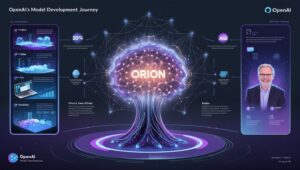
Chapter 1. Introduction: Choosing the Right Website Platform
1.1 Overview of Today’s Website Platform Landscape
In the digital age, the foundation of a successful online presence is often laid on the choice of the right website platform. This decision can significantly influence a brand’s ability to engage with its audience, streamline its operations, and expand its market reach. As we explore the landscape of website platforms, it becomes clear that platforms like Webflow, WordPress, Wix, and Squarespace have each carved out niches, catering to diverse user needs from simplicity and design flexibility to comprehensive e-commerce solutions.
The importance of selecting an appropriate platform cannot be overstated. A good match between a platform’s capabilities and a company’s requirements can lead to enhanced online visibility, improved user engagement, and ultimately, increased conversions and revenue. Conversely, a poor choice can result in frustrating limitations, unnecessary complexity, and wasted investment.
Major Platforms at a Glance:
- Webflow offers a visually-driven design approach and robust CMS capabilities without requiring users to code.
- WordPress is renowned for its extensive customization options through themes and plugins.
- Wix provides a user-friendly interface with drag-and-drop features aimed at beginners.
- Squarespace is popular for its sleek templates and straightforward content management system.
1.2 Evolution of Website Building
Tracing the evolution of website building reveals a fascinating shift from coding-heavy tasks reserved for developers to more accessible, design-focused approaches that empower creative professionals and entrepreneurs alike. This transition reflects broader technological advancements and a growing emphasis on user-friendly digital tools.
In the early days of the web, building a website was predominantly a technical endeavor, requiring deep knowledge of HTML, CSS, and later, JavaScript. This barrier to entry limited website creation to individuals with specific skills or those who could afford to hire professional developers.
The Shift to User-Friendly Platforms:
- Early 2000s: The introduction of platforms like WordPress marked a pivotal shift, making website creation accessible to non-technical users through templates and plug-ins.
- Mid-2000s to Present: Tools such as Wix and Squarespace built on this by offering even more streamlined, intuitive interfaces, focusing on design and user experience.
- The Rise of Webflow: Webflow has taken these concepts further by combining the ease of drag-and-drop editing with the power of professional-level customization, all without requiring a single line of code. This enables a more profound connection between design intent and functional execution, empowering designers and marketers to own the end-to-end web creation process.
As website platforms continue to evolve, they increasingly focus on not just simplifying the building process but also on providing powerful integrations and real-time collaboration tools. This progression towards more integrated and user-centric platforms is reshaping how businesses and individuals express their brand online, making it essential to choose a platform that not only meets current needs but also adapts to future growth and technological trends.
Chapter 2. Why Webflow Stands Out
2.1 Customizable Design and User-Friendly Interface
Webflow revolutionizes web design by merging flexibility with simplicity, offering a platform where no coding is necessary to achieve professional results. This capability not only democratizes design but also enhances the creative process, allowing designers to implement their visions directly without technical constraints.
Features:
- Visual Design Tools: Utilize the drag-and-drop editor to construct and customize layouts.
- CSS and HTML Flexibility: Adjust styles visually, with Webflow automatically generating the clean code in the background.
Advantages:
- Empowerment of Designers: Designers maintain creative control without needing to understand coding, reducing dependency on developers.
- Real-time Preview: Changes are viewable instantly, streamlining the design process and reducing the time from concept to completion.
Benefits:
- Faster Project Turnaround: With direct manipulation of design elements, projects can move more swiftly from the drafting board to live deployment.
- Lower Costs: Reduces the need for extensive development resources, allowing budget allocation to other areas like marketing or content creation.
2.2 Responsiveness Across All Devices
In a world where mobile traffic often surpasses desktop, a platform’s ability to deliver a seamless experience across all devices is not just important, it’s imperative. Webflow excels by ensuring that websites not only look good but also work well on any screen size.
Features:
- Device-Specific Design Controls: Designers can tweak layouts for desktop, tablet, and mobile views independently within the same interface.
- Flexible Grids and Containers: Use flexible grids that adapt to any screen size, improving the user experience.
Advantages:
- Enhanced User Experience: Ensures that all users, regardless of device, have a consistent and satisfying interaction with the site.
- Improved SEO Performance: Google and other search engines favor mobile-optimized sites, enhancing the site’s search rankings.
Benefits:
- Increased Engagement: A responsive site captures and retains a wider audience, increasing page views and time on site.
- Better Conversion Rates: Optimized user experience leads to higher conversion rates as users find navigating and interacting with the site easier.
2.3 Integrated Content Management and SEO Capabilities
Webflow is not just a design tool; it’s a comprehensive platform that combines the robustness of a CMS with the precision of built-in SEO tools, making it an all-in-one solution for website management.
Features:
- Dynamic Content Management: Create and manage content through a visual editor, with the ability to define custom content types and structure.
- SEO Tools: Access to edit and optimize meta tags, alt texts, and more directly within the platform, without additional plugins.
Advantages:
- Streamlined Content Updates: Marketers and content creators can edit and publish content without backend access or developer intervention.
- Enhanced Search Visibility: Built-in SEO tools ensure that content is optimized for search engines right from the start.
Benefits:
- Greater Control Over Content: Empowers non-technical users to manage and update the website’s content easily, ensuring that the site remains fresh and relevant.
- Improved Organic Reach: Optimized content increases visibility on search engines, driving more organic traffic to the site.
Webflow’s standout features not only simplify the web design and development process but also empower businesses to take full control of their online presence. By integrating design flexibility, device responsiveness, and powerful SEO capabilities, Webflow offers a platform that truly caters to the needs of modern digital landscapes.
Chapter 3. Technical Advantages of Webflow
3.1 Speed and Performance Optimization
In the fast-paced digital world, speed and performance are not just attributes but necessities for any successful online platform. Webflow excels in this arena by offering optimized performance that ensures websites not only load quickly but also operate smoothly under varying internet conditions.
Features:
- Code Optimization: Webflow generates clean, streamlined HTML, CSS, and JavaScript code, which is a key factor in reducing page load times and improving response rates.
- Content Delivery Network (CDN): Webflow utilizes a global CDN which further enhances website speed by reducing the distance data travels between servers and users.
Advantages:
- Reduced Bounce Rates: Faster site speeds lead to lower bounce rates as users are less likely to leave a site that loads quickly.
- Improved User Experience: A swift, responsive site fosters a positive user experience, keeping visitors engaged longer.
Benefits:
- Enhanced Search Engine Ranking: Speed is a ranking factor for search engines like Google. Optimized sites gain better visibility and higher rankings.
- Increased Conversion Rates: Websites that load faster see higher conversion rates, as visitors are more likely to complete transactions without delays or frustration.
3.2 Enhanced Security and Reliable Hosting
Webflow offers robust security and reliable hosting solutions that protect websites from common vulnerabilities and ensure that they remain accessible even during high traffic spikes or potential security threats.
Features:
- SSL Certificates: Webflow provides automatic SSL certification for all hosted sites, ensuring data transferred between users and the site is encrypted and secure.
- Automatic Backups and Versioning: Safeguards against data loss with frequent backups and the ability to revert to previous versions of a site.
Advantages:
- Data Protection: SSL encryption protects sensitive user data from interception by malicious actors.
- Peace of Mind: Regular backups and easy version control mean that website owners can recover quickly from human errors or malicious attacks.
Benefits:
- Trust and Credibility: Secured sites gain trust from users, crucial for retaining customers and encouraging transactions.
- Business Continuity: Reliable hosting minimizes downtime, ensuring that the website is always operational, crucial for maintaining business operations and revenue.
The technical prowess of Webflow enables businesses to maintain cutting-edge, high-performing, and secure online platforms. By harnessing the power of optimized code, a global CDN, and integrated security features, Webflow users can confidently focus on growing their digital presence without the technical headaches often associated with web development and maintenance.
Chapter 4. Operational Benefits for Teams
4.1 Streamlining the Workflow for Design and Marketing Teams
Webflow’s platform is engineered not just for individual designers but for entire teams, facilitating a collaborative and efficient workflow that is critical in today’s fast-paced digital environment. This integration of design, content, and marketing processes into a single platform markedly reduces the friction typically encountered in web development projects.
Features:
- Real-Time Collaboration: Allows multiple team members to work on the site simultaneously, with changes visible to all in real time.
- Role-Based Permissions: Enables administrators to control access levels, ensuring that team members can only modify aspects of the site relevant to their roles.
Advantages:
- Increased Productivity: By reducing the barriers between different stages of the development process, teams can execute tasks more swiftly and with fewer errors.
- Enhanced Communication: Having a centralized platform promotes better communication and understanding among team members, which is vital for maintaining brand consistency and project alignment.
Benefits:
- Faster Time to Market: Streamlined workflows mean that websites can be launched faster, which is crucial for meeting marketing deadlines and taking advantage of market opportunities.
- Reduced Overhead Costs: Minimizing the need for extensive back-and-forth between designers, developers, and content managers cuts down on project costs and management overhead.
4.2 Cost-Effectiveness and Time Savings
In addition to improving operational efficiencies, Webflow also presents significant cost benefits, particularly relevant for small to medium-sized enterprises looking to maximize their digital investment.
Features:
- All-in-One Platform: Combines design, development, and hosting services, which eliminates the need to invest in separate tools or services.
- Template and Cloneable Assets: Offers a range of pre-designed templates and assets that can becustomized, saving time and resources in design and development.
Advantages:
- Lower Total Cost of Ownership: The consolidation of multiple functions into a single platform means that businesses can save on software subscriptions, training, and integration costs.
- Scalability: Webflow’s platform is designed to scale, from simple websites to complex e-commerce platforms, allowing businesses to grow without switching systems.
Benefits:
- Budget Allocation: Savings from platform efficiencies can be redirected towards other areas such as marketing, customer service, or expansion.
- Long-Term Value: Investing in a scalable, integrated platform like Webflow provides long-term value through continuous updates and community-driven enhancements.
Webflow’s operational efficiencies not only empower teams to be more productive but also contribute significantly to the overall cost-effectiveness of managing online projects. By streamlining the design and development process and reducing the total cost of ownership, Webflow allows businesses to focus more on strategic growth and less on managing digital toolsets.
Chapter 5. Webflow for Different Types of Websites
5.1 E-commerce and Large Scale Projects
Webflow’s platform is uniquely equipped to handle the demands of e-commerce and large-scale projects, providing robust features that support complex site architectures and high-volume transactions. This capability allows businesses to scale efficiently while maintaining a high level of performance and user experience.
Features:
- Integrated E-commerce Tools: Webflow offers native e-commerce functionality, including shopping carts, inventory management, and secure checkout processes.
- Customizable Product Fields: Users can define custom product fields to suit their inventory needs, whether they sell physical goods, digital products, or services.
Advantages:
- Tailored Shopping Experiences: Businesses can create bespoke shopping experiences that align with their brand and meet the specific needs of their target audience.
- Streamlined Management: The all-in-one platform simplifies the management of products, orders, and customer data, reducing the need for separate e-commerce solutions.
Benefits:
- Increased Sales Potential: Enhanced user experiences and tailored e-commerce functionality lead to higher conversion rates and increased sales.
- Scalability: As business grows, Webflow scales to handle increased traffic and transactions without sacrificing performance.
5.2 Blogs, Portfolios, and Small Business Websites
For smaller-scale projects such as blogs, portfolios, and websites for small businesses, Webflow provides the necessary tools to create visually appealing and highly functional sites that can easily be managed by individuals or small teams.
Features:
- Dynamic Content: Webflow’s CMS allows for the creation of dynamic content like blog posts and portfolio projects with ease.
- SEO Optimization: The platform includes built-in SEO tools that help ensure content is optimized for search engines right from the start.
Advantages:
- Creative Freedom: Users have complete creative control over the design and functionality of their sites, which is crucial for personal blogs and portfolios.
- Ease of Use: The drag-and-drop interface makes it accessible even for users with limited technical skills.
Benefits:
- Enhanced Online Presence: A professional-looking website can significantly boost online visibility and credibility.
- Operational Efficiency: Small businesses benefit from Webflow’s streamlined platform, which simplifies website management and reduces the need for technical support.
Webflow’s versatility makes it an ideal choice for a wide range of website projects. From complex e-commerce sites to simple blogs, the platform’s comprehensive toolset empowers creators and businesses to build and scale their online presence effectively. Whether managing large inventories or showcasing creative portfolios, Webflow delivers performance, ease of use, and customization to meet diverse digital needs.
Chapter 6. Conclusion: Why Choose Webflow for Your Next Project
6.1 Summarizing the Strategic Advantages of Webflow
Webflow has redefined the landscape of website development with its cutting-edge design capabilities, powerful integrations, and streamlined workflows. It stands out as a superior platform by effectively blending design flexibility, comprehensive content management, and robust SEO tools into a user-friendly interface.
Key Highlights:
- Design Freedom: Webflow empowers users to bring any design vision to life without the need for extensive coding knowledge, making it accessible to designers and marketers alike.
- Responsive and Reliable: Websites built on Webflow are inherently responsive and perform well across all devices and browsers, ensuring a seamless user experience.
- Powerful SEO and CMS: Integrated SEO tools and a dynamic CMS allow businesses to maintain their competitive edge in digital marketing and content management.
Strategic Advantages:
- Operational Efficiency: Reduces the time and resources required to go from concept to launch, thanks to its intuitive user interface and powerful automation tools.
- Cost-Effective: Minimizes the need for multiple tools and platforms, thereby lowering the total cost of ownership and operational overhead.
6.2 Future Prospects in Web Development with Webflow
Looking forward, Webflow is poised to continue its trajectory as a leader in the web development space. As digital landscapes evolve, Webflow’s commitment to innovation and adaptability suggests that it will not only keep up with emerging trends but also set new standards.
Future Enhancements:
- AI-Driven Design Tools: Potential integration of AI to automate more aspects of design and development, further simplifying the creation of complex websites.
- Greater Integration Capabilities: Expanding its ecosystem to include more third-party integrations, providing users with even more tools and services directly within the platform.
Market Position:
- Leader in Innovation: Webflow is expected to remain at the forefront of web development technology, continuing to offer solutions that anticipate and meet the needs of modern businesses and designers.
- Expanding User Base: As awareness of its capabilities grows, more businesses and individual creators are likely to adopt Webflow for their web development needs, expanding its market presence and influence.
In conclusion, choosing Webflow for your next web project means investing in a platform that not only meets current digital demands but also offers a pathway to future growth and innovation. With its robust features, user-friendly design, and scalable infrastructure, Webflow provides a compelling case for anyone looking to build a powerful, responsive, and effective online presence.
FAQs
What makes Webflow different from other website builders like WordPress or Wix?
Webflow sets itself apart by offering a visual design interface that requires no coding, yet delivers highly customizable, responsive websites. Unlike WordPress, which often requires plugins for extended functionality, or Wix, which can limit design precision for the sake of simplicity, Webflow provides a powerful combination of design freedom and in-built features.
Features:
- Visual CSS styling: Webflow allows designers to style elements with the same power as CSS but in a visual canvas.
- Integrated CMS: Unlike platforms that need external CMS integrations, Webflow’s CMS is built directly into the design environment.
Advantages:
- Control and Customization: Users have unparalleled control over the website’s aesthetics and functionality without coding.
- Unified Platform: Streamlines design and content management, reducing the need for multiple tools.
Benefits:
- Enhanced Branding: Enables brands to create unique, on-brand websites that stand out in competitive markets.
- Streamlined Development Process: Saves time and resources by reducing complexity and eliminating the need for additional plugins or software.
Can Webflow handle high traffic websites?
Absolutely, Webflow is designed to support websites with high traffic volumes, providing robust hosting solutions that ensure reliability and performance.
Features:
- Global CDN: Webflow utilizes a content delivery network that ensures fast loading times worldwide.
- Automatic Scaling: Hosting infrastructure that scales automatically to handle increases in traffic.
Advantages:
- Reliability: Maintains site performance during traffic spikes.
- Speed: Enhances user experience with fast page loads, even under heavy load.
Benefits:
- User Satisfaction: Keeps visitors happy and engaged, which is crucial for high-traffic sites like e-commerce platforms.
- SEO Improvement: Fast, reliable sites are ranked better by search engines.
Is Webflow suitable for beginners in website design?
Webflow is designed to be accessible for beginners yet powerful enough for advanced users. The platform provides a range of educational resources and templates that make it easy for newcomers to start building websites.
Features:
- Template Marketplace: Offers a variety of templates that can be customized without starting from scratch.
- Webflow University: Provides comprehensive tutorials and guides to help new users learn the ropes.
Advantages:
- Learning Curve: Easier transition for beginners with little to no background in web development.
- Support Resources: Extensive documentation and a supportive community forum.
Benefits:
- Empowerment: Enables individuals and small businesses to create professional websites without hiring developers.
- Skill Development: Users can develop web design and management skills at their own pace.
How does the cost of using Webflow compare to other platforms?
Webflow provides a transparent pricing model that can be more cost-effective than competitors, especially when considering the integration of numerous features that would require paid plugins or subscriptions on other platforms.
Features:
- All-Inclusive Pricing: Webflow’s plans include hosting, CMS, and other tools without additional costs.
- No Plugins Needed: Reduces the need for paid plugins for functionality like SEO or responsive design.
Advantages:
- Cost Predictability: Users can better budget their website expenses without unexpected costs for additional features.
- Value for Money: Offers more built-in tools and capabilities, providing greater value compared to basic plans on platforms like WordPress or Wix.
Benefits:
- Reduced Overall Cost: Businesses save on the total cost of ownership by avoiding extra fees for essential features.
- Investment in Growth: Savings can be redirected into other areas such as marketing or product development.
What kind of support does Webflow offer to its users?
Webflow is committed to user success, offering a comprehensive support system that includes both automated and human assistance to ensure users can get the most out of the platform.
Features:
- Detailed Documentation: Extensive articles and how-to guides in Webflow University.
- Community Forums and Live Support: Active community forums and options for live support through chat and email.
Advantages:
- Accessibility of Information: Quick answers available through detailed, easily searchable support documents.
- Community Wisdom: Users gain not just from official support but also from a large community of Webflow users.
Benefits:
- Problem-Solving Efficiency: Users can resolve issues quickly, minimizing downtime.
- Learning and Collaboration: The community and support resources foster continuous learning and improvement.
These FAQs highlight the unique attributes of Webflow as a website builder, showcasing its capabilities to handle various web development needs while providing an efficient, scalable, and user-friendly platform.






